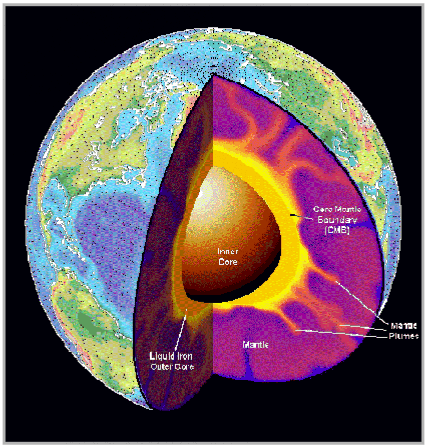6. Weakening of magnetic lines of force. Though the earth´s core produces the magnetic flux, the crust and mantel interact with that flux field.
7. Possible relocation of the ozone, or even destruction of upper atmospheric ozone. This would be due to the magnetic flux field weakening, causing the ionize oxygen to polarize and move away from the strongest points of magnetic force (poles).
8. Migration of animals from tropics to northern regions. Especially those in the oceans since the mean average temperature of the ocean would increase.
The build up to the big event would start out slowly. Look at the earth as a huge gyroscope. any one who has played with a gyro scope knows that the gyroscope tends to want to remain in its place. Any force that tries to move it is met with resistance, that resistance, in this case, is internal and will cause heat. More resistance to the rotational momentum would take a long period of time to reach the critical breaking point. With the imbalance of the crust, it would require a few decades to reach that moment.
The earth is naturally resistant to any movements from its rotational direction. however, once the process is started, it will increase due to the natural imbalance of the crustal mass. We can assume that the crust slip is part and parcel of plate tectonics. We all know that the Continental plates move in relation of one another. This is a slow process, however it is a continual process which will eventually knock the earth out of sync with its rotation leading to a massive crustal slippage every so often.
What you may be seeing is the opening geological moments to the big event.
There is reason to believe that this has happened before. We have found mammoths quick frozen which suggests that there was an instant cooling period. This stands to reason when we consider that a large amount of debris will be kicked into the air by volcanoes erupting. There is also evidence in the laying down of mass volcanic lava flows in a short period of time. Further, the rocks record sudden ´pole-shifts´ of the magnetic fields of earth.
Since life continued to exist through and beyond these periods taking centuries to die off, we can assume that though the crust slip was sudden (in geologic terms) it was the long term effects of crust slippage and not the event itself which lead to the extinctions. All the things you have uncovered here point at a crust slippage.
You are looking for an external source (planet X) to an internal problem which is caused by the naturally occurring tectonic movements of the earth. The safest place on earth is off of earth. Not on some other planet, but in orbit during this crust slip. With a maximum time for any slippage (due to friction) anyone could live in orbit during that period.
Another ´safe´ place, not as safe as being off earth, would be any geologically stable area on earth that is above the 500 elevation mark. Such areas would be any place that are solid rock. Montana is one such place. Being underground would be safer than being on the surface considering the high winds and the enviable acid rain (from volcanic gasses) and from monster storms caused by the sudden release of moisture through heating of the oceans.
Look at the development of the ´concentration´ camps and the underground bunkers. Compare the geologic stability and altitude of the areas a certain pattern will emerge early. The initial build up to a crustal slip would take decades, possibly even a century. It would be a gradual process, appearing to be a ´normal´ change of state at first.
We could assume that since seismology is a new science (mind the 1906 earth quake was estimated, not recorded) and that seismographs are a rather new kid on the block, that it isn´t until most recently that scientists have ´discovered´ the problem with earth.
Through out the past 50 decades we know that the number and severity of earth quakes have been on the rise. We can also show a rise in the mean temperature of the earth and other tail tell signs which have, until most recently, been thought of as the normal ebb and flow of the earth.
The red herring of Global Warming may have lead many down the wrong road. This is not to say that Global warming is not playing a factor in the climatological events we are witnessing. However, the estimates of carbons to climate change have shown that climate change is going faster than the calculations have shown.
Again, this is not being caused by outside forces, it is the result of plate tectonics and the natural imbalance of the earth. All one has to do is look at a globe of the earth and we see that there is a Land Hemisphere and a Water hemisphere. This is not to say that there is no Planet X. Planet X may be very real, however, it is way to far away to have any impact on the movements of the Earth at this time.
All of my calculations were averaged out and rounded off. Anyone can figure these things out if they used the estimated mass of the crust to the estimated total mass of the earth, and if they know how to calculate energy from acceleration.





